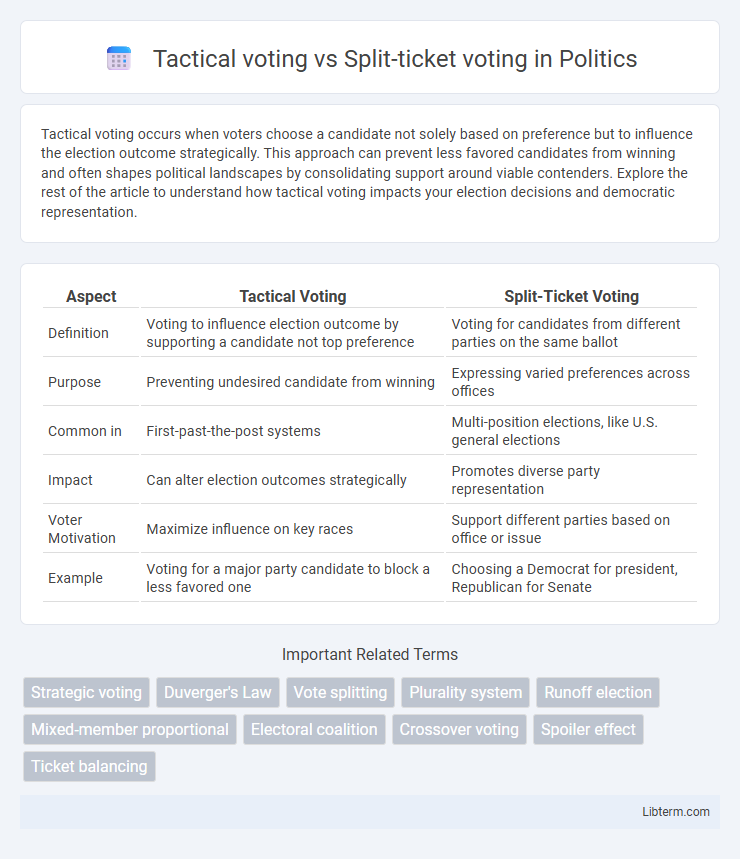Tactical voting occurs when voters choose a candidate not solely based on preference but to influence the election outcome strategically. This approach can prevent less favored candidates from winning and often shapes political landscapes by consolidating support around viable contenders. Explore the rest of the article to understand how tactical voting impacts your election decisions and democratic representation.
Table of Comparison
| Aspect | Tactical Voting | Split-Ticket Voting |
|---|---|---|
| Definition | Voting to influence election outcome by supporting a candidate not top preference | Voting for candidates from different parties on the same ballot |
| Purpose | Preventing undesired candidate from winning | Expressing varied preferences across offices |
| Common in | First-past-the-post systems | Multi-position elections, like U.S. general elections |
| Impact | Can alter election outcomes strategically | Promotes diverse party representation |
| Voter Motivation | Maximize influence on key races | Support different parties based on office or issue |
| Example | Voting for a major party candidate to block a less favored one | Choosing a Democrat for president, Republican for Senate |
Understanding Tactical Voting
Tactical voting involves casting a ballot not for a preferred candidate, but for one more likely to win and prevent an undesired outcome, often in closely contested elections. This strategy contrasts with split-ticket voting, where voters select candidates from different parties for different offices within the same election, reflecting varied preferences rather than strategic considerations. Understanding tactical voting requires analyzing voter behavior patterns, electoral system incentives, and the impact on election results and party dynamics.
What is Split-Ticket Voting?
Split-ticket voting occurs when voters select candidates from different political parties for different offices within the same election, reflecting a preference for individual candidates rather than party loyalty. This voting behavior can lead to divided government, where executive and legislative branches are controlled by different parties, influencing policy-making and legislative negotiations. Split-ticket voting contrasts with tactical voting, where voters choose candidates strategically to prevent an undesirable outcome, often supporting a less preferred but more viable candidate.
Key Differences Between Tactical and Split-Ticket Voting
Tactical voting involves selecting a candidate not because they are the first choice, but to prevent an undesirable candidate from winning, which often leads to strategic ballot decisions. Split-ticket voting occurs when a voter chooses candidates from different political parties for different offices in the same election, reflecting a preference for diverse party representation. The key difference lies in tactical voting's focus on strategic outcomes in a single race, while split-ticket voting emphasizes varied party support across multiple races simultaneously.
Motivations Behind Tactical Voting
Tactical voting occurs when voters choose a candidate they perceive as more viable to prevent an undesired outcome, often motivated by strategic calculations to influence the overall election result. This behavior contrasts with split-ticket voting, where voters select candidates from different parties for different offices based on personal preferences rather than strategic considerations. Motivations behind tactical voting include minimizing wasted votes, thwarting frontrunners perceived as unfavorable, and maximizing the impact of a vote in closely contested races.
Why Voters Choose Split-Ticket Voting
Voters choose split-ticket voting to express nuanced preferences by selecting candidates from different parties for various offices, reflecting a desire for balanced government representation. This approach allows voters to support individual candidates based on merit rather than party loyalty, often driven by local issues or candidate qualifications. Split-ticket voting can also serve as a check against political polarization by encouraging diverse legislative bodies.
Effects on Election Outcomes
Tactical voting strategically maximizes a voter's impact by supporting a less preferred but more viable candidate to prevent an undesirable outcome, often altering election results by consolidating votes and reducing vote splitting. Split-ticket voting occurs when voters choose candidates from different parties for various offices, increasing the chances of divided government and complicating party dominance. Both behaviors significantly influence electoral outcomes by shaping candidate viability, party power balance, and legislative decision-making dynamics.
Impacts on Political Representation
Tactical voting reshapes political representation by enabling voters to support candidates with the greatest chance of defeating undesired opponents, often consolidating power within major parties and reducing the success of minor parties. Split-ticket voting promotes a more diverse political landscape by allowing voters to choose candidates from different parties for different offices, enhancing cross-party representation and potentially encouraging bipartisan cooperation. Both behaviors influence the electoral system's ability to reflect complex voter preferences and can alter the balance of power within legislative bodies.
Tactical Voting in Different Electoral Systems
Tactical voting involves voters choosing candidates not solely based on preference but to influence election outcomes strategically within specific electoral systems. In plurality or first-past-the-post systems, tactical voting often leads to support for major parties to prevent vote splitting and wasted votes. Proportional representation systems reduce the need for tactical voting by allowing votes to contribute more directly to party representation, though tactical decisions can still occur in mixed or transferable vote systems.
Split-Ticket Voting Trends and Patterns
Split-ticket voting trends reveal a growing pattern of voters selecting candidates from different parties across various offices in the same election. This behavior reflects increasing voter independence and issue-based choices rather than strict party loyalty. Data indicates a rise in split-ticket voting in swing districts, influencing election outcomes and campaign strategies.
Future Implications for Democratic Processes
Tactical voting, where voters strategically choose candidates to influence election outcomes, can lead to more polarized political landscapes by reinforcing dominant parties and marginalizing smaller ones. Split-ticket voting, allowing voters to select candidates from different parties on the same ballot, promotes greater representation and accountability by encouraging diversity in legislative bodies. The future of democratic processes hinges on balancing these behaviors to enhance both political stability and voter expression, ensuring electoral systems adapt to evolving voter strategies.
Tactical voting Infographic

 libterm.com
libterm.com